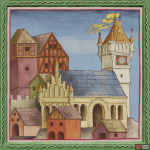Text
Early Gothic buildings in Bohemia were inspired by France and the Rhineland. Among the earliest were the monastery in Předklášteří near Tišnov, South Moravia, the chapter house in Osek, North Bohemia, the monastery of St Agnes in Prague and many parish churches and monasteries such as those in Kolin and Kouřim in Central Bohemia.
At the turn of the 13th and 14th centuries, Czech architecture diverged from its western counterparts. There was a burgeoning of Cistercian monasteries, e.g. in Zlatá Koruna and Vyšší Brod in South Bohemia, and churches and castles, e.g. Bezděz, North Bohemia. The High Gothic period was ushered in during the time of ![]() Charles IV and
Charles IV and ![]() Wenceslas IV, with its rectangular windows and portals, rayonnant traceries and quadripartite, sexpartite, or cross-ribbed vaulting.
Wenceslas IV, with its rectangular windows and portals, rayonnant traceries and quadripartite, sexpartite, or cross-ribbed vaulting.
The most significant buildings of that time include Charles University, St Vitus Cathedral, Charles Bridge, Prague Old Town Hall and New Town Hall, stone houses in Prague and the castles of Karlštejn, Kost and Kašperk.
Records of construction work fellowships first appear during this time: the most famous are those of Master Peter Parler and his family, and Matthias of Arras, who also worked on the reconstruction of Sasau Monastery.
New castles no longer served just a defensive function, but were also intended to serve as royal residences. They were therefore more spacious and elaborate and had extensive gardens.


No Comments